Texans are very proud of their flourishing peach industry, and with good reason. According to Texas A&M University’s Aggie Horticulture, Texas produces an average of over one million bushels of peaches per year! Each successful peach season in Texas is possible because of the ideal climate and soil that keep over a million peach trees thriving. Though many factors can affect annual crop yields, early to mid-summer is the peak time for Texas’s juiciest peach harvests.
Which months in Texas are the busiest during peach harvest season? Scroll down to discover peak harvest timing and much more about the bustling peach season in Texas. We’ll discuss how to tell when peaches are ripe, the harvesting process, and some common types of peaches Texas orchards grow.
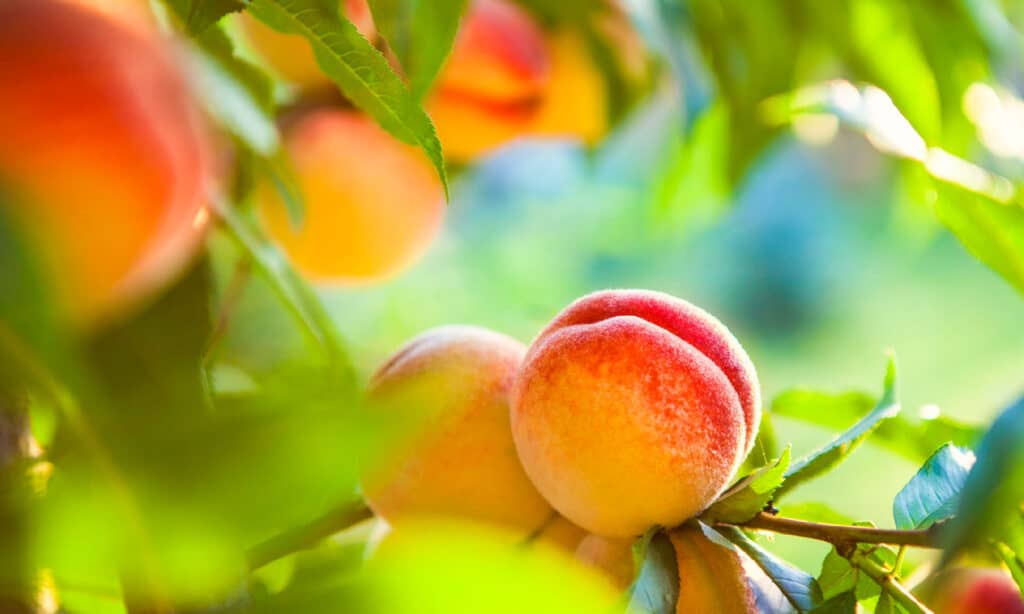
Peach season in Texas begins in mid-May and lasts until the end of August.
©iStock.com/takoburito
When is the peak season for Texas peaches?
The peach harvest in Texas and other southern states usually starts in the middle of May and finishes by the end of August. So the peak of peach season in Texas typically occurs in June and July. However, keep in mind that different peach varieties might ripen at different times.
Additionally, the weather can change the timing of the peak season, at least slightly, each year. For example, AgriLife Today reported that some Texas peach trees suffered “late freeze damage and inadequate chill hours” in 2023. As a result, the peak months for the 2023 peach season in some parts of Texas were May and June.
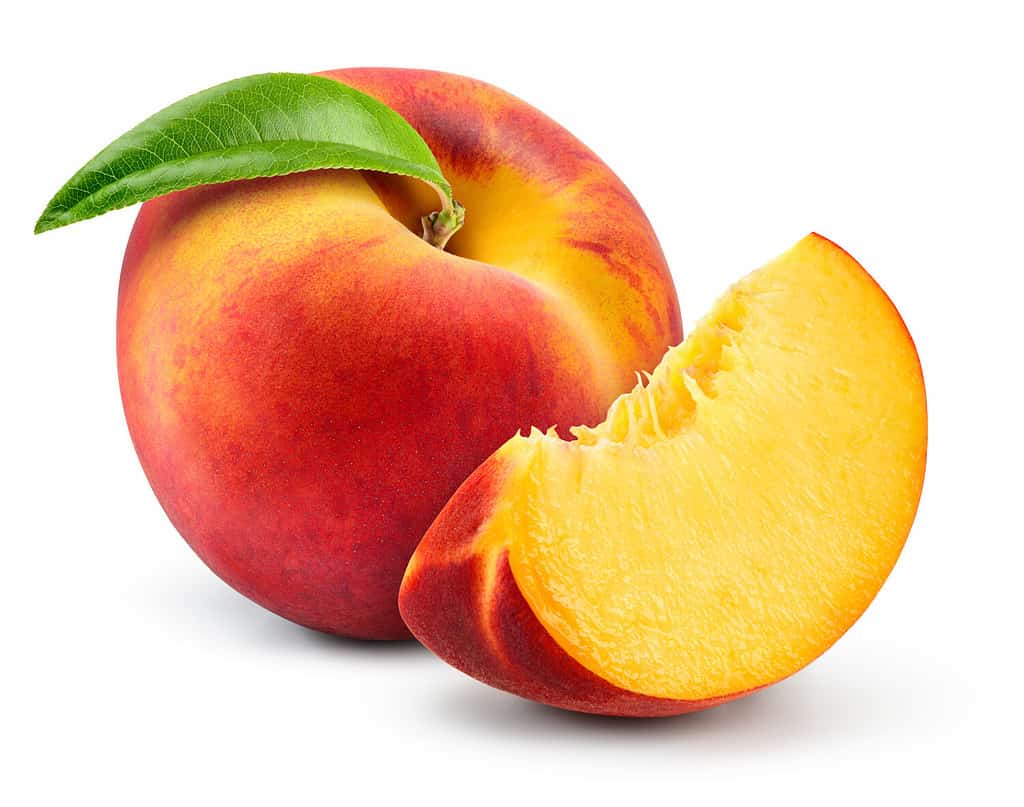
Some Texas peaches have yellow flesh, while others have white flesh.
©Tim UR/Shutterstock.com
Which peach varieties grow in Texas?
Texas is home to many fruit trees, including many peach varieties. Whether it’s a Flavorich peach in May or a Redskin peach in July, the peach season in Texas offers a big selection of stone fruit. See the table below for a list of peach varieties that are popular in the Hill Country area of Texas and other regions. We also note the peach types and peak harvest timing for each.
| Variety of Peach | Type of Peach | Peak Ripeness |
|---|---|---|
| Flavorich | Clingstone | Early to Mid-May |
| Regal | Clingstone | Mid to Late May |
| Southern Pearl | Semi-Freestone | Early to Mid-June |
| Rich Lady | Semi-Freestone | Early to Mid-June |
| Majestic | Freestone | Late June to Early July |
| Redskin | Freestone | Mid to Late July |
| Parade | Freestone | Mid to Late August |
Are you familiar with the three main types of peaches: clingstone, freestone, and semi-freestone? Peaches ripen at different times based on their type, in addition to their variety. Keep reading to learn more about peach types and their differences!

Freestone peaches have pits (stones) that are easy to remove from inside the flesh.
©Nerza/Shutterstock.com
Clingstone vs. Freestone Peaches
Another factor that affects peak timing for the peach season in Texas is the type of peaches grown. For example, a clingstone peach usually ripens earlier in the season than a freestone peach. So most of the early spring peaches are clingstone types.
If you don’t know the difference between a clingstone vs. freestone peach, you’ve come to the right place! Here’s a quick explanation of each, plus info about a hybrid that combines the best qualities of each.
- The Clingstone Peach: You’ll notice four distinct differences when you compare a clingstone peach to a freestone variety. The clingstone peach is smaller, sweeter, juicier and hangs on to its stone (pit) for dear life. In fact, the name for this type of peach derived from how it “clings” to the stone. Additionally, clingstone peaches sometimes have white flesh instead of the traditionally yellow flesh under their skin. Most clingstone peaches ripen early during the peach season in Texas.
- The Freestone Peach: The freestone peach is bigger than a clingstone and has a center stone that’s very easy to remove. Freestone peaches are also sweet, juicy, and worth every bite. They’re the easiest fruit to eat fresh off the tree since the flesh separates from the stone so easily. In addition, freestone is the largest type of peach and usually ripens in the mid to late season.
- The Semi-Freestone Peach: A semi-freestone or semi-cling peach is a hybrid that combines the extra juiciness of the clingstone with an easier-to-remove stone inside. However, semi-freestone peaches are less available than the other peach types. The timing of ripeness for semi-freestone peaches varies by variety but typically ripens mid-season.
Now that you know how to recognize the peach types, do you know how to tell when a peach is ripe? See below for some quick tips for testing a peach’s ripeness!
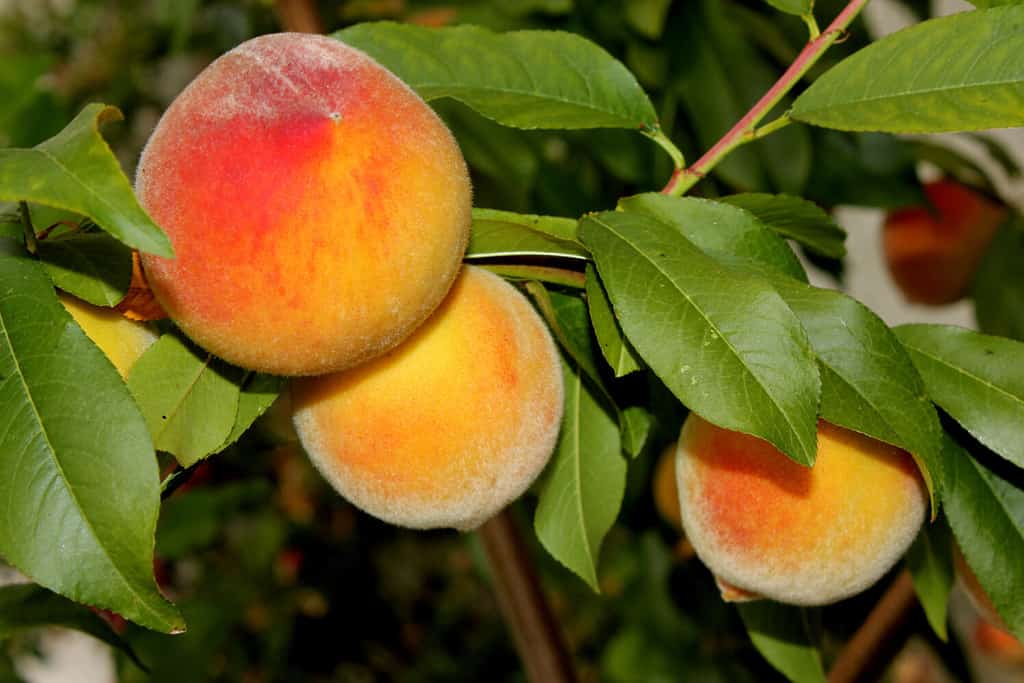
A ripe peach will have a yellow background and no hint of greenish tones.
©Gurcharan Singh/Shutterstock.com
How do you test peaches for ripeness?
Peach season in Texas begins with some peaches ripening in the early season while others ripen later as the weeks of summer fly by. How do you know when a peach is ripe? You can test the peach’s firmness, color, scent, and taste.
- Peach Firmness: If you give the peach a gentle squeeze and it has a little bit of give, it’s probably ripe and ready for eating. The best place to press lightly on this sweet Texas fruit is at the top near the stem. If the peach has no give to the flesh underneath the skin, it probably needs more time to ripen. And if the peach is mushy? It’s overripe but probably still delicious!
- Peach Color: Does the peach still have a greenish tone on the skin? If so, it’s not ripe enough to eat yet. The background color of a ripe peach will be a golden yellow with no hints of green.
- Peach Scent: Ripe peaches have a strong, sweet smell! And peach trees full of ripe peaches will release their wonderful aroma through the air. So smell a peach before you pluck it from the branch. If it doesn’t have much of a sweet scent yet, let it ripen longer on the tree.
- Peach Taste: If you don’t mind picking a tester peach, pull one off the tree that seems ripe. Then taste it to determine if it’s juicy, sweet, and has tender flesh. If it does, your peach is ready, and some of the other peaches on the same tree are probably also ripe at the same time. However, if the peach is still tart and the flesh isn’t quite soft, you may want to wait before harvesting more peaches off that tree.
Some peach trees produce fruit that all ripen at the same time. Other trees will have peaches ripening at their own pace.
If the peaches you want to pick are ripe on the tree, gently twist them to remove them from the branches. You can also tug the peach in a slightly upward motion. If the peach doesn’t want to come off the branch, it might need more time to ripen fully.
Remember that peaches keep ripening after harvest.
It’s also important to note that peaches continue to ripen after they are removed from the tree. This trait of climacteric fruit means the best timing for picking ripe peaches is an important consideration for growers. Texas farmers who need to pack and ship their peaches consider the extra time between harvesting and when a ripe peach reaches the people who buy and eat it.
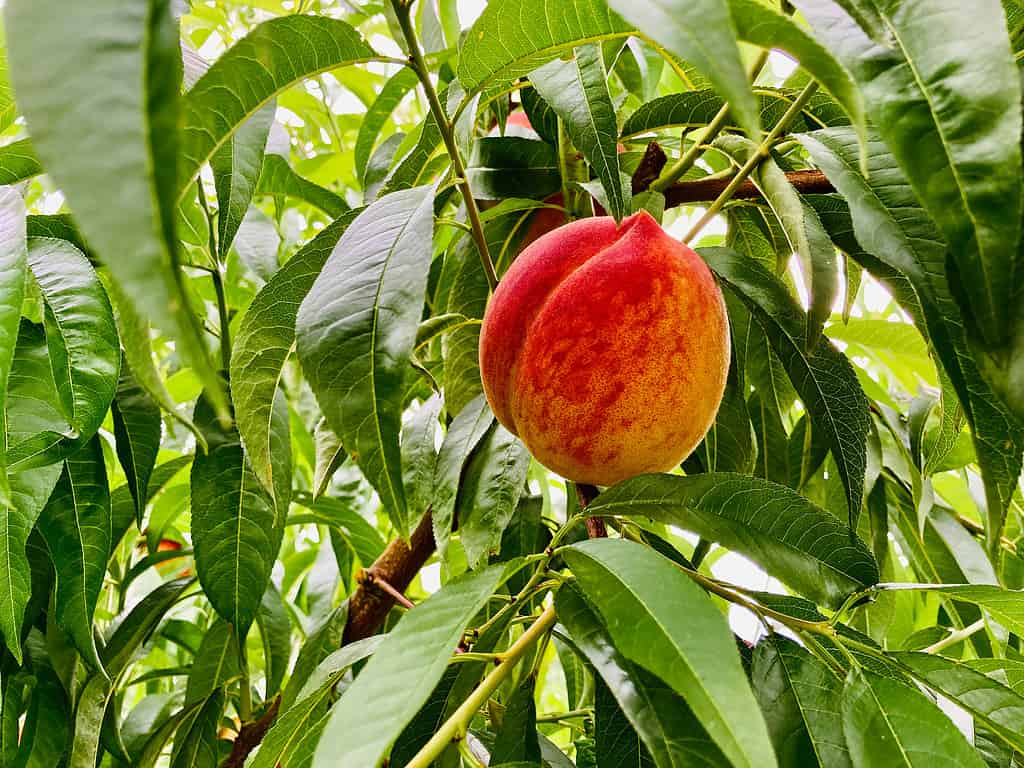
To pick a peach, gently twist it off the branch at the stem.
©Zdena Venclik/Shutterstock.com
Peach Harvesting in Texas
Each farm or orchard has its own harvesting methods that differ slightly for these Texas crops. However, most peaches are handpicked and usually processed onsite before selling or shipping to various markets.
The extension horticulturists at Texas A&M University suggest the following steps as standard ones for peach harvesting:
- Peach season in Texas begins with hand-harvesting. Workers pick peaches off the trees and place them into containers like wooden crates, baskets, or picking bags with bottoms that drop open.
- Picked peaches then go into carts or trailers for transport from the orchard to the onsite packing house, when applicable.
- At the packing house, the freshly picked peaches are washed, defuzzed, graded, packed, and stored. If packed for shipping, peaches similar in size are usually packed in the same box.
- Peaches are kept in cold storage until sold at a local market or shipped elsewhere.
Peach Harvesting Equipment
Some peach farmers use special equipment to help the harvesting process along. Farm equipment might include a tree shaker, a massive machine that shakes the fruit from the tree and drops it into a catching frame. Other equipment could include fruit sorting machines, packing machines, and peach pitters when needed.
Whether storing and packing machines are used, most Texas peach growers still use handpicking methods to protect the fruit from damage. Handpicking also makes quality control easier from the first step of the harvesting process.
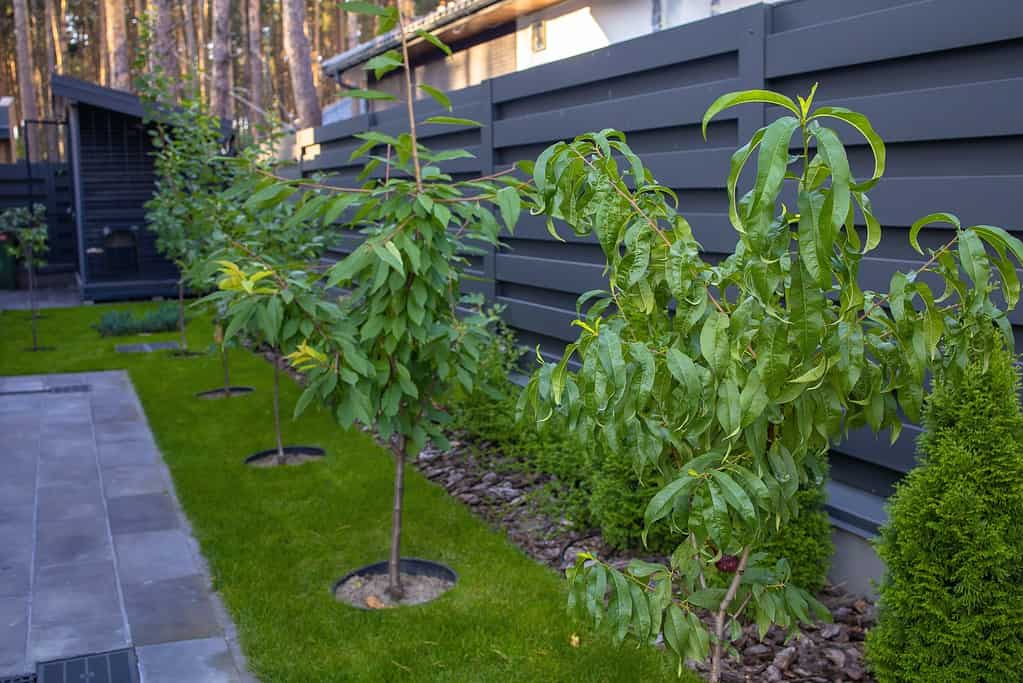
Peach trees grow well in sandy, loamy soil and warm climates with mild winters.
©Vitaliy Karimov/Shutterstock.com
How long have peaches been a crop in Texas?
Peach isn’t a native Texas tree, but peaches first became a crop in Texas in the late 1800s. By 1910, well over 100,000 peach trees were growing in the state. Nowadays, there are thriving orchards in many counties. For example, the counties of Hill Country, southern Gillespie County, and Parker County are hotbeds of peach production in the state. Furthermore, Parker County is officially known (via House Resolution 203) as the Peach Capital of Texas.
Why are peaches such a successful crop in Texas? Scroll down for the details!

Harvesting peaches is still usually done by hand in Texas and other states.
©Alexey Stiop/Shutterstock.com
Why are peaches grown in Texas?
Growing peach trees takes special conditions and care. Fortunately, the soil nutrients and consistency, plus its warm climate, make Texas ideal for peach tree cultivation. Especially the areas of Texas with well-draining sandy and loamy soil produce high-quality peaches on healthy trees. Additionally, the mild winters in central and southern Texas help ensure that peach trees fill with magnificent pink blossoms in the spring.
That said, negative factors like insect pests, disease, and abnormal weather events are challenges for Texas peach growers. So each year’s (and each farm’s) successful crop yield depends on a balance of ideal conditions and tree protections.
Peach season in Texas is as sweet as the fruit it produces.
The sweet smell of fresh peaches drifting across the state of Texas in summer is a major highlight of the year. No wonder Texans are so proud of their bountiful peach industry! But the peach season in Texas takes a lot of hard work during peak harvest between May and late August. Enjoy the sweet fruit of their labor, whether in a pie or straight from the bowl. Then start counting the days until, thankfully, the peach season in Texas rolls around again.
The photo featured at the top of this post is © BearFotos/Shutterstock.com
Thank you for reading! Have some feedback for us? Contact the AZ Animals editorial team.







